Deck 13: Structure Determination: Nuclear Magnetic Resonance Spectroscopy
Question
Question
Question
Question
Question
Question
Question
Question
Question
Question
Question
Question
Question
Question
Question
Question
Question
Question
Question
Question
Question
Question
Question
Question
Question
Question
Question
Question
Question
Question
Question
Question
Question
Question
Question
Question
Question
Question
Question
Question
Question
Question
Question
Question
Question
Question

Unlock Deck
Sign up to unlock the cards in this deck!
Unlock Deck
Unlock Deck
1/46
Play
Full screen (f)
Deck 13: Structure Determination: Nuclear Magnetic Resonance Spectroscopy
1
Treatment of tert-butyl alcohol with hydrogen chloride yields a mixture of tert-butyl chloride (SN1 product) and 2-methylpropene (E1 product).After chromatographic separation,how would you use 1H NMR to help you decide which was which? 

2-Methylpropene has two kinds of hydrogens.It will have a vinylic absorption (4.5−6.5 δ) representing two hydrogens and an unsplit signal (1.0−1.5 δ) due to the six equivalent methyl hydrogens.
tert-Butyl chloride has only one kind of hydrogen,which results in one unsplit signal.
tert-Butyl chloride has only one kind of hydrogen,which results in one unsplit signal.
2
Exhibit 13-9
To answer the following question(s),consider the data and 1H NMR spectrum below:
The mass spectrum of this compound shows a molecular ion at m/z = 113,the IR spectrum has characteristic absorptions at 2270 and 1735 cm−1,and the 13C NMR spectrum has five signals. Spectrum obtained from: SDBSWeb: http://www.aist.go.jp/RIODB/SDBS/
Spectrum obtained from: SDBSWeb: http://www.aist.go.jp/RIODB/SDBS/
Refer to Exhibit 13-9.Describe the signal at 3.5 δ in terms of its integration,splitting pattern and chemical shift.
To answer the following question(s),consider the data and 1H NMR spectrum below:
The mass spectrum of this compound shows a molecular ion at m/z = 113,the IR spectrum has characteristic absorptions at 2270 and 1735 cm−1,and the 13C NMR spectrum has five signals.
 Spectrum obtained from: SDBSWeb: http://www.aist.go.jp/RIODB/SDBS/
Spectrum obtained from: SDBSWeb: http://www.aist.go.jp/RIODB/SDBS/Refer to Exhibit 13-9.Describe the signal at 3.5 δ in terms of its integration,splitting pattern and chemical shift.
The integration of the signal at 3.5 δ indicates that it is due to two equivalent hydrogens,probably a −CH2− group.Since the signal is a singlet (not split) there are no nonequivalent hydrogens attached to the atoms adjacent to the carbon to which these two hydrogens are bonded.The chemical shift to 3.5 δ indicates that this −CH2− group has at least one electronegative atom or group bonded to it,possibly a carbonyl group.
3
For a nucleus to exhibit the nuclear magnetic resonance phenomenon,it must be magnetic.Magnetic nuclei include:
A)all nuclei with even numbers of neutrons and protons
B)all nuclei with odd numbers of protons
C)all nuclei with odd numbers of neutrons
D)both b and c
A)all nuclei with even numbers of neutrons and protons
B)all nuclei with odd numbers of protons
C)all nuclei with odd numbers of neutrons
D)both b and c
both b and c
4
Exhibit 13-8
Below are three isomeric chlorobutanes and their 13C NMR spectral data.MATCH the spectral data to the correct structures by placing the letter of the spectrum in the blank to the left of the corresponding structure.
a = δ,55.4,36.2,19.3
b = δ,56.2,35.3
c = δ,56.0,36.0,24.2,8.2
_____
Below are three isomeric chlorobutanes and their 13C NMR spectral data.MATCH the spectral data to the correct structures by placing the letter of the spectrum in the blank to the left of the corresponding structure.
a = δ,55.4,36.2,19.3
b = δ,56.2,35.3
c = δ,56.0,36.0,24.2,8.2
_____


Unlock Deck
Unlock for access to all 46 flashcards in this deck.
Unlock Deck
k this deck
5
Explain why all protons in a molecule do not absorb rf energy at the same frequency.

Unlock Deck
Unlock for access to all 46 flashcards in this deck.
Unlock Deck
k this deck
6
Exhibit 13-1
The following question(s) pertain to the charting of NMR spectra.MATCH a term to each description below.Place the letter of the term in the blank to the left of the description.
a.TMS
e.low-field or downfield side
b.high-field or upfield side
f.chemical shift
c.MHz
g.specific absorption
d.delta (δ)
_____ The NMR charts are calibrated using an arbitrary scale that is divided into _____ units.
The following question(s) pertain to the charting of NMR spectra.MATCH a term to each description below.Place the letter of the term in the blank to the left of the description.
a.TMS
e.low-field or downfield side
b.high-field or upfield side
f.chemical shift
c.MHz
g.specific absorption
d.delta (δ)
_____ The NMR charts are calibrated using an arbitrary scale that is divided into _____ units.

Unlock Deck
Unlock for access to all 46 flashcards in this deck.
Unlock Deck
k this deck
7
Exhibit 13-8
Below are three isomeric chlorobutanes and their 13C NMR spectral data.MATCH the spectral data to the correct structures by placing the letter of the spectrum in the blank to the left of the corresponding structure.
a = δ,55.4,36.2,19.3
b = δ,56.2,35.3
c = δ,56.0,36.0,24.2,8.2
_____
Below are three isomeric chlorobutanes and their 13C NMR spectral data.MATCH the spectral data to the correct structures by placing the letter of the spectrum in the blank to the left of the corresponding structure.
a = δ,55.4,36.2,19.3
b = δ,56.2,35.3
c = δ,56.0,36.0,24.2,8.2
_____


Unlock Deck
Unlock for access to all 46 flashcards in this deck.
Unlock Deck
k this deck
8
Exhibit 13-9
To answer the following question(s),consider the data and 1H NMR spectrum below:
The mass spectrum of this compound shows a molecular ion at m/z = 113,the IR spectrum has characteristic absorptions at 2270 and 1735 cm−1,and the 13C NMR spectrum has five signals. Spectrum obtained from: SDBSWeb: http://www.aist.go.jp/RIODB/SDBS/
Spectrum obtained from: SDBSWeb: http://www.aist.go.jp/RIODB/SDBS/
Refer to Exhibit 13-9.Propose a structure for this compound.
To answer the following question(s),consider the data and 1H NMR spectrum below:
The mass spectrum of this compound shows a molecular ion at m/z = 113,the IR spectrum has characteristic absorptions at 2270 and 1735 cm−1,and the 13C NMR spectrum has five signals.
 Spectrum obtained from: SDBSWeb: http://www.aist.go.jp/RIODB/SDBS/
Spectrum obtained from: SDBSWeb: http://www.aist.go.jp/RIODB/SDBS/Refer to Exhibit 13-9.Propose a structure for this compound.

Unlock Deck
Unlock for access to all 46 flashcards in this deck.
Unlock Deck
k this deck
9
Nuclear magnetic resonance spectroscopy provides information about a molecule's:
A)conjugated pi electron system.
B)size and formula.
C)carbon-hydrogen framework.
D)functional groups.
A)conjugated pi electron system.
B)size and formula.
C)carbon-hydrogen framework.
D)functional groups.

Unlock Deck
Unlock for access to all 46 flashcards in this deck.
Unlock Deck
k this deck
10
Exhibit 13-9
To answer the following question(s),consider the data and 1H NMR spectrum below:
The mass spectrum of this compound shows a molecular ion at m/z = 113,the IR spectrum has characteristic absorptions at 2270 and 1735 cm−1,and the 13C NMR spectrum has five signals. Spectrum obtained from: SDBSWeb: http://www.aist.go.jp/RIODB/SDBS/
Spectrum obtained from: SDBSWeb: http://www.aist.go.jp/RIODB/SDBS/
Refer to Exhibit 13-9.How many types of nonequivalent protons are there in this molecule?
To answer the following question(s),consider the data and 1H NMR spectrum below:
The mass spectrum of this compound shows a molecular ion at m/z = 113,the IR spectrum has characteristic absorptions at 2270 and 1735 cm−1,and the 13C NMR spectrum has five signals.
 Spectrum obtained from: SDBSWeb: http://www.aist.go.jp/RIODB/SDBS/
Spectrum obtained from: SDBSWeb: http://www.aist.go.jp/RIODB/SDBS/Refer to Exhibit 13-9.How many types of nonequivalent protons are there in this molecule?

Unlock Deck
Unlock for access to all 46 flashcards in this deck.
Unlock Deck
k this deck
11
Exhibit 13-10
Answer the question(s) for the compound whose 1H NMR spectra is shown below.
C4H8O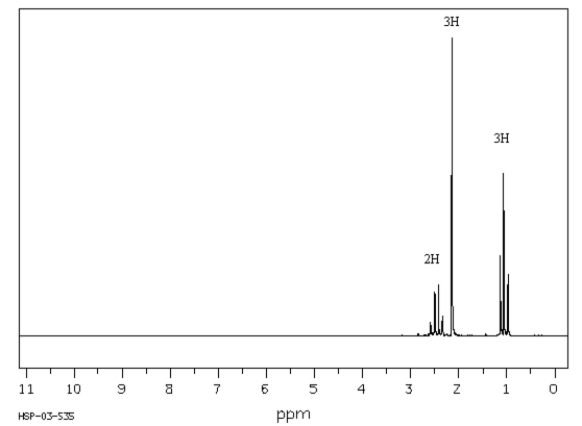 Spectrum obtained from: SDBSWeb: http://www.aist.go.jp/RIODB/SDBS/
Spectrum obtained from: SDBSWeb: http://www.aist.go.jp/RIODB/SDBS/
Refer to Exhibit 13-10.Propose a structure for this compound.
Answer the question(s) for the compound whose 1H NMR spectra is shown below.
C4H8O
 Spectrum obtained from: SDBSWeb: http://www.aist.go.jp/RIODB/SDBS/
Spectrum obtained from: SDBSWeb: http://www.aist.go.jp/RIODB/SDBS/Refer to Exhibit 13-10.Propose a structure for this compound.

Unlock Deck
Unlock for access to all 46 flashcards in this deck.
Unlock Deck
k this deck
12
How would you use 1H and 13C NMR to help you distinguish between these two isomeric structures? 


Unlock Deck
Unlock for access to all 46 flashcards in this deck.
Unlock Deck
k this deck
13
Exhibit 13-10
Answer the question(s) for the compound whose 1H NMR spectra is shown below.
C4H8O Spectrum obtained from: SDBSWeb: http://www.aist.go.jp/RIODB/SDBS/
Spectrum obtained from: SDBSWeb: http://www.aist.go.jp/RIODB/SDBS/
Refer to Exhibit 13-10.Describe each signal in terms of its integration,splitting and chemical shift.
Answer the question(s) for the compound whose 1H NMR spectra is shown below.
C4H8O
 Spectrum obtained from: SDBSWeb: http://www.aist.go.jp/RIODB/SDBS/
Spectrum obtained from: SDBSWeb: http://www.aist.go.jp/RIODB/SDBS/Refer to Exhibit 13-10.Describe each signal in terms of its integration,splitting and chemical shift.

Unlock Deck
Unlock for access to all 46 flashcards in this deck.
Unlock Deck
k this deck
14
Exhibit 13-8
Below are three isomeric chlorobutanes and their 13C NMR spectral data.MATCH the spectral data to the correct structures by placing the letter of the spectrum in the blank to the left of the corresponding structure.
a = δ,55.4,36.2,19.3
b = δ,56.2,35.3
c = δ,56.0,36.0,24.2,8.2
_____
Below are three isomeric chlorobutanes and their 13C NMR spectral data.MATCH the spectral data to the correct structures by placing the letter of the spectrum in the blank to the left of the corresponding structure.
a = δ,55.4,36.2,19.3
b = δ,56.2,35.3
c = δ,56.0,36.0,24.2,8.2
_____


Unlock Deck
Unlock for access to all 46 flashcards in this deck.
Unlock Deck
k this deck
15
Exhibit 13-9
To answer the following question(s),consider the data and 1H NMR spectrum below:
The mass spectrum of this compound shows a molecular ion at m/z = 113,the IR spectrum has characteristic absorptions at 2270 and 1735 cm−1,and the 13C NMR spectrum has five signals. Spectrum obtained from: SDBSWeb: http://www.aist.go.jp/RIODB/SDBS/
Spectrum obtained from: SDBSWeb: http://www.aist.go.jp/RIODB/SDBS/
Refer to Exhibit 13-9.Based on the mass spectral data and the IR data,what functional groups are present in this compound?
To answer the following question(s),consider the data and 1H NMR spectrum below:
The mass spectrum of this compound shows a molecular ion at m/z = 113,the IR spectrum has characteristic absorptions at 2270 and 1735 cm−1,and the 13C NMR spectrum has five signals.
 Spectrum obtained from: SDBSWeb: http://www.aist.go.jp/RIODB/SDBS/
Spectrum obtained from: SDBSWeb: http://www.aist.go.jp/RIODB/SDBS/Refer to Exhibit 13-9.Based on the mass spectral data and the IR data,what functional groups are present in this compound?

Unlock Deck
Unlock for access to all 46 flashcards in this deck.
Unlock Deck
k this deck
16
Exhibit 13-9
To answer the following question(s),consider the data and 1H NMR spectrum below:
The mass spectrum of this compound shows a molecular ion at m/z = 113,the IR spectrum has characteristic absorptions at 2270 and 1735 cm−1,and the 13C NMR spectrum has five signals. Spectrum obtained from: SDBSWeb: http://www.aist.go.jp/RIODB/SDBS/
Spectrum obtained from: SDBSWeb: http://www.aist.go.jp/RIODB/SDBS/
Refer to Exhibit 13-9.Describe the signals at 4.35 δ and 1.3 δ in terms of their integration,splitting and chemical shift.
To answer the following question(s),consider the data and 1H NMR spectrum below:
The mass spectrum of this compound shows a molecular ion at m/z = 113,the IR spectrum has characteristic absorptions at 2270 and 1735 cm−1,and the 13C NMR spectrum has five signals.
 Spectrum obtained from: SDBSWeb: http://www.aist.go.jp/RIODB/SDBS/
Spectrum obtained from: SDBSWeb: http://www.aist.go.jp/RIODB/SDBS/Refer to Exhibit 13-9.Describe the signals at 4.35 δ and 1.3 δ in terms of their integration,splitting and chemical shift.

Unlock Deck
Unlock for access to all 46 flashcards in this deck.
Unlock Deck
k this deck
17
Exhibit 13-1
The following question(s) pertain to the charting of NMR spectra.MATCH a term to each description below.Place the letter of the term in the blank to the left of the description.
a.TMS
e.low-field or downfield side
b.high-field or upfield side
f.chemical shift
c.MHz
g.specific absorption
d.delta (δ)
_____ The exact place on the chart at which a nucleus absorbs is called its _____.
The following question(s) pertain to the charting of NMR spectra.MATCH a term to each description below.Place the letter of the term in the blank to the left of the description.
a.TMS
e.low-field or downfield side
b.high-field or upfield side
f.chemical shift
c.MHz
g.specific absorption
d.delta (δ)
_____ The exact place on the chart at which a nucleus absorbs is called its _____.

Unlock Deck
Unlock for access to all 46 flashcards in this deck.
Unlock Deck
k this deck
18
Exhibit 13-1
The following question(s) pertain to the charting of NMR spectra.MATCH a term to each description below.Place the letter of the term in the blank to the left of the description.
a.TMS
e.low-field or downfield side
b.high-field or upfield side
f.chemical shift
c.MHz
g.specific absorption
d.delta (δ)
_____ The calibration standard for 1H and 13C NMR is _____.
The following question(s) pertain to the charting of NMR spectra.MATCH a term to each description below.Place the letter of the term in the blank to the left of the description.
a.TMS
e.low-field or downfield side
b.high-field or upfield side
f.chemical shift
c.MHz
g.specific absorption
d.delta (δ)
_____ The calibration standard for 1H and 13C NMR is _____.

Unlock Deck
Unlock for access to all 46 flashcards in this deck.
Unlock Deck
k this deck
19
Exhibit 13-1
The following question(s) pertain to the charting of NMR spectra.MATCH a term to each description below.Place the letter of the term in the blank to the left of the description.
a.TMS
e.low-field or downfield side
b.high-field or upfield side
f.chemical shift
c.MHz
g.specific absorption
d.delta (δ)
_____ When looking at an NMR chart the right-hand part of the chart is the _____.
The following question(s) pertain to the charting of NMR spectra.MATCH a term to each description below.Place the letter of the term in the blank to the left of the description.
a.TMS
e.low-field or downfield side
b.high-field or upfield side
f.chemical shift
c.MHz
g.specific absorption
d.delta (δ)
_____ When looking at an NMR chart the right-hand part of the chart is the _____.

Unlock Deck
Unlock for access to all 46 flashcards in this deck.
Unlock Deck
k this deck
20
Exhibit 13-9
To answer the following question(s),consider the data and 1H NMR spectrum below:
The mass spectrum of this compound shows a molecular ion at m/z = 113,the IR spectrum has characteristic absorptions at 2270 and 1735 cm−1,and the 13C NMR spectrum has five signals. Spectrum obtained from: SDBSWeb: http://www.aist.go.jp/RIODB/SDBS/
Spectrum obtained from: SDBSWeb: http://www.aist.go.jp/RIODB/SDBS/
Refer to Exhibit 13-9.What is the significance of the 13C NMR data?
To answer the following question(s),consider the data and 1H NMR spectrum below:
The mass spectrum of this compound shows a molecular ion at m/z = 113,the IR spectrum has characteristic absorptions at 2270 and 1735 cm−1,and the 13C NMR spectrum has five signals.
 Spectrum obtained from: SDBSWeb: http://www.aist.go.jp/RIODB/SDBS/
Spectrum obtained from: SDBSWeb: http://www.aist.go.jp/RIODB/SDBS/Refer to Exhibit 13-9.What is the significance of the 13C NMR data?

Unlock Deck
Unlock for access to all 46 flashcards in this deck.
Unlock Deck
k this deck
21
What type of NMR spectrum is the following? 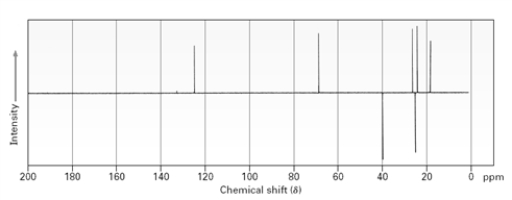
A)broadband decoupled
B)DEPT-90
C)DEPT-135
D)It is not possible to judge given just the spectrum.

A)broadband decoupled
B)DEPT-90
C)DEPT-135
D)It is not possible to judge given just the spectrum.

Unlock Deck
Unlock for access to all 46 flashcards in this deck.
Unlock Deck
k this deck
22
Exhibit 13-12
Answer the question(s) for the compound whose 1H NMR spectra is shown below.
C8H7ClO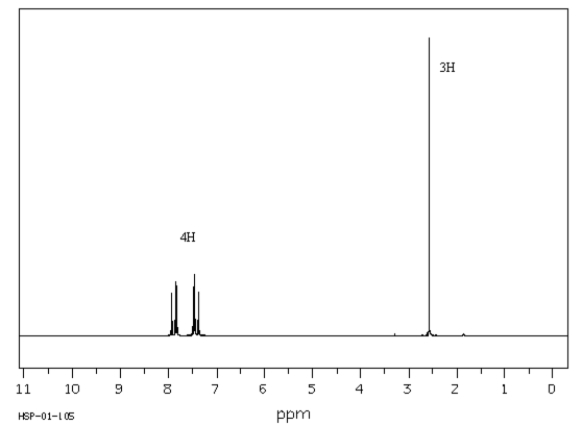 Spectrum obtained from: SDBSWeb: http://www.aist.go.jp/RIODB/SDBS/
Spectrum obtained from: SDBSWeb: http://www.aist.go.jp/RIODB/SDBS/
Refer to Exhibit 13-12.Propose a structure for this compound.
Answer the question(s) for the compound whose 1H NMR spectra is shown below.
C8H7ClO
 Spectrum obtained from: SDBSWeb: http://www.aist.go.jp/RIODB/SDBS/
Spectrum obtained from: SDBSWeb: http://www.aist.go.jp/RIODB/SDBS/Refer to Exhibit 13-12.Propose a structure for this compound.

Unlock Deck
Unlock for access to all 46 flashcards in this deck.
Unlock Deck
k this deck
23
Identify the splitting pattern of the numbered protons.Atoms other than hydrogen and carbon are labeled. 
A)1: doublet,2: triplet
B)1: triplet,2: triplet
C)1: quartet 2: quartet
D)1: singlet,2: triplet

A)1: doublet,2: triplet
B)1: triplet,2: triplet
C)1: quartet 2: quartet
D)1: singlet,2: triplet

Unlock Deck
Unlock for access to all 46 flashcards in this deck.
Unlock Deck
k this deck
24
Which of the following occurs when a DEPT-135 spectrum is run?
A)CH3,CH carbons appear as positive signals
B)CH2 carbons appears as a negative signal
C)quaternary carbon signals are absent
D)a and b
E)all of the above
A)CH3,CH carbons appear as positive signals
B)CH2 carbons appears as a negative signal
C)quaternary carbon signals are absent
D)a and b
E)all of the above

Unlock Deck
Unlock for access to all 46 flashcards in this deck.
Unlock Deck
k this deck
25
Which structure of molecular formula C4H8Cl2 fits both the 1H NMR and 13C NMR spectra shown below?
A)
B)
C)
D)
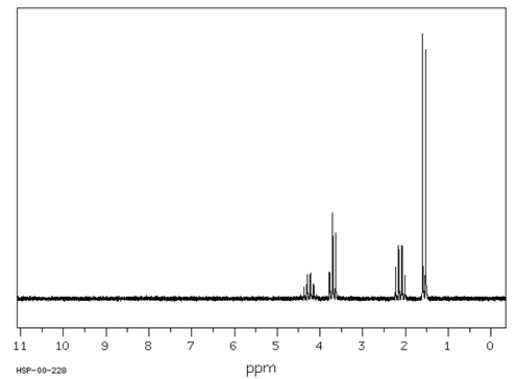
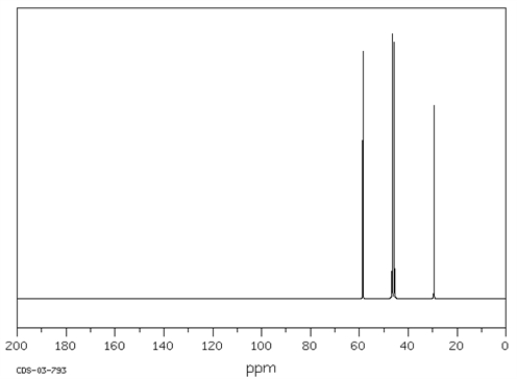 Spectra obtained from: SDBSWeb: http://www.aist.go.jp/RIODB/SDBS/
Spectra obtained from: SDBSWeb: http://www.aist.go.jp/RIODB/SDBS/
A)

B)

C)

D)


 Spectra obtained from: SDBSWeb: http://www.aist.go.jp/RIODB/SDBS/
Spectra obtained from: SDBSWeb: http://www.aist.go.jp/RIODB/SDBS/
Unlock Deck
Unlock for access to all 46 flashcards in this deck.
Unlock Deck
k this deck
26
The following is the tree diagram for the protons on a specific carbon.  Which of the following signals in a proton NMR could correspond to these protons?
Which of the following signals in a proton NMR could correspond to these protons?
A)
B)
C)
D)
E)None of these due to the coupling constants.
 Which of the following signals in a proton NMR could correspond to these protons?
Which of the following signals in a proton NMR could correspond to these protons?A)

B)

C)

D)

E)None of these due to the coupling constants.

Unlock Deck
Unlock for access to all 46 flashcards in this deck.
Unlock Deck
k this deck
27
Which of the following provides information about the carbon framework of a molecule?
A)
B)
C)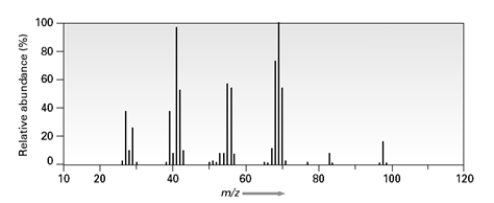
D)
A)

B)

C)

D)


Unlock Deck
Unlock for access to all 46 flashcards in this deck.
Unlock Deck
k this deck
28
Exhibit 13-12
Answer the question(s) for the compound whose 1H NMR spectra is shown below.
C8H7ClO Spectrum obtained from: SDBSWeb: http://www.aist.go.jp/RIODB/SDBS/
Spectrum obtained from: SDBSWeb: http://www.aist.go.jp/RIODB/SDBS/
Refer to Exhibit 13-12.Describe the signals that occur between 7 and 8 δ in terms of integration,splitting and chemical shift.
Answer the question(s) for the compound whose 1H NMR spectra is shown below.
C8H7ClO
 Spectrum obtained from: SDBSWeb: http://www.aist.go.jp/RIODB/SDBS/
Spectrum obtained from: SDBSWeb: http://www.aist.go.jp/RIODB/SDBS/Refer to Exhibit 13-12.Describe the signals that occur between 7 and 8 δ in terms of integration,splitting and chemical shift.

Unlock Deck
Unlock for access to all 46 flashcards in this deck.
Unlock Deck
k this deck
29
Exhibit 13-11
Answer the question(s) for the compound whose 1H NMR spectra is shown below.
C5H12O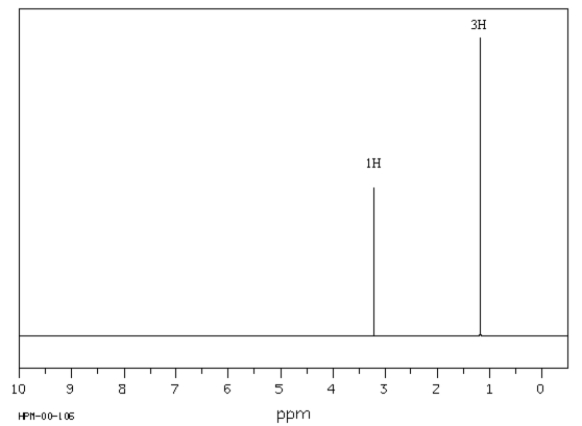 Spectrum obtained from: SDBSWeb: http://www.aist.go.jp/RIODB/SDBS/
Spectrum obtained from: SDBSWeb: http://www.aist.go.jp/RIODB/SDBS/
Refer to Exhibit 13-11.Describe each signal in the 1H NMR in terms of its integration,splitting and chemical shift.
Answer the question(s) for the compound whose 1H NMR spectra is shown below.
C5H12O
 Spectrum obtained from: SDBSWeb: http://www.aist.go.jp/RIODB/SDBS/
Spectrum obtained from: SDBSWeb: http://www.aist.go.jp/RIODB/SDBS/Refer to Exhibit 13-11.Describe each signal in the 1H NMR in terms of its integration,splitting and chemical shift.

Unlock Deck
Unlock for access to all 46 flashcards in this deck.
Unlock Deck
k this deck
30
Consider the following structure.Atoms other than carbon and hydrogen are labeled.The carbon atoms are designated by numbers. 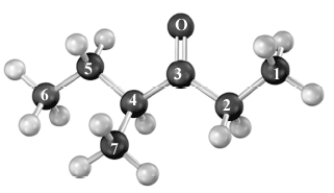 Which carbon atom(s) will produce a signal in a DEPT-90 spectrum?
Which carbon atom(s) will produce a signal in a DEPT-90 spectrum?
A)1,6 and 7
B)2 and 5
C)3
D)4
E)All will produce a signal.
 Which carbon atom(s) will produce a signal in a DEPT-90 spectrum?
Which carbon atom(s) will produce a signal in a DEPT-90 spectrum?A)1,6 and 7
B)2 and 5
C)3
D)4
E)All will produce a signal.

Unlock Deck
Unlock for access to all 46 flashcards in this deck.
Unlock Deck
k this deck
31
Exhibit 13-12
Answer the question(s) for the compound whose 1H NMR spectra is shown below.
C8H7ClO Spectrum obtained from: SDBSWeb: http://www.aist.go.jp/RIODB/SDBS/
Spectrum obtained from: SDBSWeb: http://www.aist.go.jp/RIODB/SDBS/
Refer to Exhibit 13-12.Calculate the degree of unsaturation in this compound.
Answer the question(s) for the compound whose 1H NMR spectra is shown below.
C8H7ClO
 Spectrum obtained from: SDBSWeb: http://www.aist.go.jp/RIODB/SDBS/
Spectrum obtained from: SDBSWeb: http://www.aist.go.jp/RIODB/SDBS/Refer to Exhibit 13-12.Calculate the degree of unsaturation in this compound.

Unlock Deck
Unlock for access to all 46 flashcards in this deck.
Unlock Deck
k this deck
32
Propose a structure for Compound X,which has M+ = 120 and (M + 2) = 122 of approximately equal intensity in its mass spectrum and has the following 13C NMR spectral data:
Broadband decoupled 13C NMR:
32.6,118.8,134.3 δ
DEPT-90:
134.3 δ
DEPT-135:
positive peaks at 134.3 δ;negative peaks at 32.6,118.8 δ
Broadband decoupled 13C NMR:
32.6,118.8,134.3 δ
DEPT-90:
134.3 δ
DEPT-135:
positive peaks at 134.3 δ;negative peaks at 32.6,118.8 δ

Unlock Deck
Unlock for access to all 46 flashcards in this deck.
Unlock Deck
k this deck
33
Which signal(s) remain(s) when a DEPT-90 spectrum is run?
A)CH3
B)CH2
C)CH
D)quaternary C
E)a,b,c
A)CH3
B)CH2
C)CH
D)quaternary C
E)a,b,c

Unlock Deck
Unlock for access to all 46 flashcards in this deck.
Unlock Deck
k this deck
34
Describe how you could differentiate the following compounds using a DEPT NMR experiment. 


Unlock Deck
Unlock for access to all 46 flashcards in this deck.
Unlock Deck
k this deck
35
Propose a structure for Compound Z,which has the following spectroscopic properties:
MS:
M+ = 88
IR:
3380 cm−1
1H NMR:
0.85 δ (6H doublet);1.40 δ (3H multiplet);2.68 δ (1H singlet);3.55 δ (2H triplet)
Broadband decoupled 13C NMR:
22.7,25.0,41.8,60.5 δ
DEPT-90:
25.0 δ
DEPT-135:
positive peaks at 22.7,25.0 δ;negative peaks at 41.8,60.5 δ
MS:
M+ = 88
IR:
3380 cm−1
1H NMR:
0.85 δ (6H doublet);1.40 δ (3H multiplet);2.68 δ (1H singlet);3.55 δ (2H triplet)
Broadband decoupled 13C NMR:
22.7,25.0,41.8,60.5 δ
DEPT-90:
25.0 δ
DEPT-135:
positive peaks at 22.7,25.0 δ;negative peaks at 41.8,60.5 δ

Unlock Deck
Unlock for access to all 46 flashcards in this deck.
Unlock Deck
k this deck
36
Propose a structure for a compound,C6H14O,with the following 13C NMR spectral data:
Broadband decoupled 13C NMR:
23.0,68.4 δ
DEPT-90:
68.4 δ
DEPT-135:
positive peaks at 23.0,68.4 δ;no negative peaks
Broadband decoupled 13C NMR:
23.0,68.4 δ
DEPT-90:
68.4 δ
DEPT-135:
positive peaks at 23.0,68.4 δ;no negative peaks

Unlock Deck
Unlock for access to all 46 flashcards in this deck.
Unlock Deck
k this deck
37
Exhibit 13-11
Answer the question(s) for the compound whose 1H NMR spectra is shown below.
C5H12O Spectrum obtained from: SDBSWeb: http://www.aist.go.jp/RIODB/SDBS/
Spectrum obtained from: SDBSWeb: http://www.aist.go.jp/RIODB/SDBS/
Refer to Exhibit 13-11.Calculate the degree of unsaturation for this compound.
Answer the question(s) for the compound whose 1H NMR spectra is shown below.
C5H12O
 Spectrum obtained from: SDBSWeb: http://www.aist.go.jp/RIODB/SDBS/
Spectrum obtained from: SDBSWeb: http://www.aist.go.jp/RIODB/SDBS/Refer to Exhibit 13-11.Calculate the degree of unsaturation for this compound.

Unlock Deck
Unlock for access to all 46 flashcards in this deck.
Unlock Deck
k this deck
38
Exhibit 13-12
Answer the question(s) for the compound whose 1H NMR spectra is shown below.
C8H7ClO Spectrum obtained from: SDBSWeb: http://www.aist.go.jp/RIODB/SDBS/
Spectrum obtained from: SDBSWeb: http://www.aist.go.jp/RIODB/SDBS/
Refer to Exhibit 13-12.Describe the signal at 2.6 δ in terms of integration,splitting and chemical shift.
Answer the question(s) for the compound whose 1H NMR spectra is shown below.
C8H7ClO
 Spectrum obtained from: SDBSWeb: http://www.aist.go.jp/RIODB/SDBS/
Spectrum obtained from: SDBSWeb: http://www.aist.go.jp/RIODB/SDBS/Refer to Exhibit 13-12.Describe the signal at 2.6 δ in terms of integration,splitting and chemical shift.

Unlock Deck
Unlock for access to all 46 flashcards in this deck.
Unlock Deck
k this deck
39
How many signals would appear in the proton NMR for the following substance? Atoms other than carbon and hydrogen are labeled. 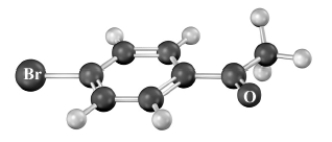
A)2
B)3
C)4
D)5

A)2
B)3
C)4
D)5

Unlock Deck
Unlock for access to all 46 flashcards in this deck.
Unlock Deck
k this deck
40
Exhibit 13-11
Answer the question(s) for the compound whose 1H NMR spectra is shown below.
C5H12O Spectrum obtained from: SDBSWeb: http://www.aist.go.jp/RIODB/SDBS/
Spectrum obtained from: SDBSWeb: http://www.aist.go.jp/RIODB/SDBS/
Refer to Exhibit 13-11.Propose a structure for this compound.
Answer the question(s) for the compound whose 1H NMR spectra is shown below.
C5H12O
 Spectrum obtained from: SDBSWeb: http://www.aist.go.jp/RIODB/SDBS/
Spectrum obtained from: SDBSWeb: http://www.aist.go.jp/RIODB/SDBS/Refer to Exhibit 13-11.Propose a structure for this compound.

Unlock Deck
Unlock for access to all 46 flashcards in this deck.
Unlock Deck
k this deck
41
Identify the different types of protons in 1-chloro-2-butene.What would be the chemical shift observed for each type of proton? 


Unlock Deck
Unlock for access to all 46 flashcards in this deck.
Unlock Deck
k this deck
42
Find all the types of nonequivalent protons in the given compound. 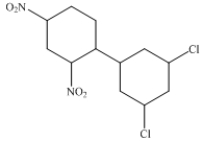


Unlock Deck
Unlock for access to all 46 flashcards in this deck.
Unlock Deck
k this deck
43
What would be the approximate positions at which you would expect 2-chloro-3-butyne to show 13C NMR absorptions? 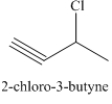


Unlock Deck
Unlock for access to all 46 flashcards in this deck.
Unlock Deck
k this deck
44
Identify the two numbered hydrogen atoms as: 
A)unrelated
B)homotopic
C)enantiotopic
D)diastereotopic

A)unrelated
B)homotopic
C)enantiotopic
D)diastereotopic

Unlock Deck
Unlock for access to all 46 flashcards in this deck.
Unlock Deck
k this deck
45
The molecular formula of a certain compound is C4H9OBr.It has the following 1H NMR data: 1.30 δ (6H,singlet),3.94 δ (2H,doublet),and 2.51 δ (1H,triplet).Propose a structure for the compound using the information given.

Unlock Deck
Unlock for access to all 46 flashcards in this deck.
Unlock Deck
k this deck
46
Propose a structure for an alkyl halide,C4H9Br,that has the following 13C NMR data:
Broadband decoupled 13C NMR: 18.3,38.6,60.2 δ
DEPT-90: 38.6 δ
DEPT-135: positive peak at 18.3,60.2 δ;negative peak at 38.6 δ
Broadband decoupled 13C NMR: 18.3,38.6,60.2 δ
DEPT-90: 38.6 δ
DEPT-135: positive peak at 18.3,60.2 δ;negative peak at 38.6 δ

Unlock Deck
Unlock for access to all 46 flashcards in this deck.
Unlock Deck
k this deck



